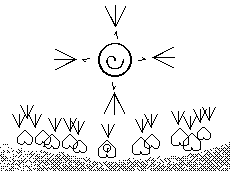Haiku and the Pictograph in Earth Language (EL) - January 2005 -
"The hot, yellow sun" 「照り照る日」 by Loli Karas

 .
.  .
.  .
. 
 .
. 

This is an EL (Earth Language)
experimental page to enjoy
the image of a haiku/short poem
originally in English/Japanese.
When you can't see the Japanese parts,
please don't mind and just skip those parts.
地球語の文字や文字絵を用いて詩的表現や翻訳を試みる実験のページです。
A Happy New Year to You!
In 2004, natural and man-made disasters raged in many places on
earth.
The people, who suffered them, you must still be hard in chill.
On the other side of the earth, the sun is shining now like
this haiku by Loli Karas(8) in Melbourne;
and the sun will return to brighten your day like this again. Please
warm up yourself by this image.
This haiku is taken from
CHILDREN'S HAIKU GARDEN.
あけましておめでとうございます。
雪の中の地震被災地の子どもたちやお年寄りに、同じ時期の地球の反対側を想像しながら
こんな俳句であたたまってもらいたいとおもいました。一日も早く、彼らにも輝きがもどりますように・・
メルボルンの Loli
Karasさん(8歳)の作で、
CHILDREN'S HAIKU GARDENで見つけた俳句です。
英語文化では、太陽はふつう黄色にイメージされて、この俳句でも黄色です。
みなさんには今日の太陽が何色に見えますか?
 Original haiku by Loli
Karas:
Original haiku by Loli
Karas:
The hot, yellow sun,
Gleaming and glowing away,
It brightens our day.
Japanese translation:
照り照る日みなのひと日を輝かし
EL translation:
















The symbols in the pictograph:
 : light (光),
: light (光),  : the sun (太陽),
: the sun (太陽),  : radiating
(放射),
: radiating
(放射),  : life (命),
: life (命),
 : I/my (私)
: I/my (私)
The symbols in the translation:
 {
{  heat,
heat,  much}:
hot (熱い)
much}:
hot (熱い)
 : conjunction;
and (接続符;そして)
: conjunction;
and (接続符;そして)
 {
{ color,
color,  outward}: yellow (黄色)
outward}: yellow (黄色)
 {
{ open energy
open energy  globe}: the sun (太陽)
globe}: the sun (太陽)

 {verb symbol,
{verb symbol,  preposition}: indicating
that the verb formed by this and the following character(s) modifies the
front words.(前の語を修飾する動詞を構成する符)
preposition}: indicating
that the verb formed by this and the following character(s) modifies the
front words.(前の語を修飾する動詞を構成する符)
 : verb-symbol to form a verb with the
following character(s), meaning that the subject of the sentence becomes
into the situation that the following character(s) shows. (主語が後続語の状態に成るという意味で動詞を構成する動詞符)
: verb-symbol to form a verb with the
following character(s), meaning that the subject of the sentence becomes
into the situation that the following character(s) shows. (主語が後続語の状態に成るという意味で動詞を構成する動詞符)
 as a picture like compounded
character: light (光)
as a picture like compounded
character: light (光)

 shine/gleam (光る)
shine/gleam (光る)
 {{
{{


 }
} toward all directions,
toward all directions,
 open energy}: radiation (放射する状態)
open energy}: radiation (放射する状態)


 radiate with light/ glowing away (光を放つ)
radiate with light/ glowing away (光を放つ)
 {
{ pronoun indicator,
pronoun indicator,  dot}: that/it
or its (pointing the subject of the topics (その)
dot}: that/it
or its (pointing the subject of the topics (その)
 : verb-symbol
to form a verb with the following character(s), meaning that the subject
of the sentence makes something/someone with
: verb-symbol
to form a verb with the following character(s), meaning that the subject
of the sentence makes something/someone with  to be/do into the situation shown by the following characters.
to be/do into the situation shown by the following characters.
(主語が につづく語を何らかの状態にさせるという意味で動詞を構成する符)
につづく語を何らかの状態にさせるという意味で動詞を構成する符)
 : to indicate that the following character(s)
is what actually becomes the situation, which the verb with
: to indicate that the following character(s)
is what actually becomes the situation, which the verb with  shows.
shows.
 {
{ plural,
plural, I, my {
I, my { behind,
behind,  pronoun indicator}
pronoun indicator}
(corresponding to the EL hand-sign, pointing own chest): we/our/us (わたしたち(の))
 {
{ time related to
time related to  }: day (日)
}: day (日)
Translations by Yoshiko
To th top















 : light (光),
: light (光),  : the sun (太陽),
: the sun (太陽),  : radiating
(放射),
: radiating
(放射),  : I/my (私)
: I/my (私) {
{  {
{ color,
color,  outward}: yellow (黄色)
outward}: yellow (黄色) {
{ open energy
open energy  globe}: the sun (太陽)
globe}: the sun (太陽)
 {verb symbol,
{verb symbol,  preposition}: indicating
that the verb formed by this and the following character(s) modifies the
front words.(前の語を修飾する動詞を構成する符)
preposition}: indicating
that the verb formed by this and the following character(s) modifies the
front words.(前の語を修飾する動詞を構成する符) : verb-symbol to form a verb with the
following character(s), meaning that the subject of the sentence becomes
into the situation that the following character(s) shows. (主語が後続語の状態に成るという意味で動詞を構成する動詞符)
: verb-symbol to form a verb with the
following character(s), meaning that the subject of the sentence becomes
into the situation that the following character(s) shows. (主語が後続語の状態に成るという意味で動詞を構成する動詞符) as a picture like compounded
character: light (光)
as a picture like compounded
character: light (光)
 shine/gleam (光る)
shine/gleam (光る) {{
{{ }
} toward all directions,
toward all directions,
 open energy}: radiation (放射する状態)
open energy}: radiation (放射する状態)

 radiate with light/ glowing away (光を放つ)
radiate with light/ glowing away (光を放つ) {
{ dot}: that/it
or its (pointing the subject of the topics (その)
dot}: that/it
or its (pointing the subject of the topics (その) to be/do into the situation shown by the following characters.
to be/do into the situation shown by the following characters. につづく語を何らかの状態にさせるという意味で動詞を構成する符)
につづく語を何らかの状態にさせるという意味で動詞を構成する符) : to indicate that the following character(s)
is what actually becomes the situation, which the verb with
: to indicate that the following character(s)
is what actually becomes the situation, which the verb with  {
{ I, my {
I, my { behind,
behind,  {
{ }: day (日)
}: day (日) Original haiku by Loli
Karas:
Original haiku by Loli
Karas: